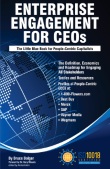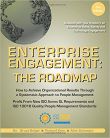Tech Firm Publishes ISO Conforming Human Capital Report as a Marketing Strategy, Not Compliance
Digital Future Group, a technology development firm with offices in the US, Ukraine, and Russia, has published a formal human capital report consistent with the format of ISO 30414 Human Capital and ISO 10018 People Engagement standards.
To demonstrate to customers and employees how it delivers its promises to people, the Digital Future Group has published a comprehensive human capital report detailing its people management strategies and metrics in a format consistent with the 14 categories in ISO 30414 Human Capital and ISO 10018 People Engagement standards addressing all stakeholders. Although Digital Future Group is privately held, it has published this report to demonstrate to its growing number of clients that it has a strategic and systematic approach to people that can support their rapidly expanding needs.
This is the first human capital report known to use a presentation format systematically aligned with ISO 30414 and ISO 10018 standards to facilitate comparisons between companies. The company has begun the process of having the report independently verified by an ISO 30414 certified auditor to confirm the methodology and validity of the information disclosed.
This report is intended to serve as a model for other public or private companies seeking to disclose meaningful human capital information to their stakeholders in a comparable and auditable manner. The EEA chose the ISO framework, as ISO standards are understood worldwide and provide a flexible yet comparable means of reporting on purpose, goals, metrics, results, and action plans.
This report was developed in conjunction with the Engagement Agency's human capital advisory service. The Engagement Agency is a division of the Enterprise Engagement Alliance at TheEEA.org.
ESM readers are invited to comment on the efficacy of this report format and its contents. E-mail Bruce Bolger at Bolger@TheICEE.org.
This report was developed in conjunction with the Engagement Agency's human capital advisory service. The Engagement Agency is a division of the Enterprise Engagement Alliance at TheEEA.org.
ESM readers are invited to comment on the efficacy of this report format and its contents. E-mail Bruce Bolger at Bolger@TheICEE.org.
Human Capital Report
Digital Future Group
Holding company for JetRuby, Jet Solutions and OZ Solutions
July 2020 - June 2021
Table of Contents
Summary
Our core business strategy is to help companies create software applications that delight their customers by engaging the world’s finest talent in software development. We publish this report to transparently demonstrate to all stakeholders the strategies and metrics we use to fulfill our promises and plan to have the information provided here independently audited. While we make every attempt to provide information to help our stakeholders understand how we implement and measure our promise delivery, as a privately held company we do withhold some information that would provide competitive advantages to other companies.
Here is an overview of the human strategies and metrics detailed in the report below.
Leadership. Our mission is to attract and engage top talent around the world to help tech companies develop great SaaS products that delight their customers or employees, measured by customer and employee engagement, willingness to recommend, and turnover. Our main challenge this year is higher than acceptable rate of employee turnover due to high demand for tech talent, which we are addressing through expanded recognition and management training detailed in this report.
Diversity, Equity, Inclusion. While we can now consider recruiting from around the world, most of our employees are in Eastern Europe. We look for talented people of all ages, races, ethnicities, and gender preferences and provide basic and advanced training to continually enhance our productivity and quality through internal development, measured by diversity and levels of participation in our training and engagement efforts and mobility.
Occupational Health and Safety. Since most of our employees work at home, we focus on providing COVID education and holding virtual rallies and other activities to promote physical activity and camaraderie. We track absenteeism, wellness, and participation in our wellness activities.
Organizational Culture. We seek to deeply engage our people in the mission to become long-term business partners for our clients through ongoing communications, team meetings, and recognition, plus: competitive base salary, various bonuses, four-weeks paid vacation, sick pay, clear mobility, professional development and even help during unexpected hardships. We conduct ongoing assessment using OfficeVibe and track turnover, mobility, willingness to recommend and more.
Productivity. The key to productivity is to increasingly help employees enhance their capabilities. We track Human Capital Value Add, ROI, revenues per employee, etc. against against customer satisfaction. We have seen significant gains in Human Capital Value Add and ROI with no erosion in customer satisfaction through our talent development strategy.
Skills and Capabilities. We provide technical learning starting in local universities and for employees at each stage with a goal of creating a farm team and internal source for senior talent. We track internal mobility, training outcomes, participation, and employee retention, and are satisfied with the results of our internal development progress.
Recruitment. Because we have a “farm team” and internal development strategy, most of our recruiting is for senior management. We measure the cost of recruitment and onboarding, and are pleased that our costs have actually gone down in these categories.
Employee bench strength, mobility, and turnover. Because our strategy is based on having a farm team and promoting from within, our problem is not bench strength but rather retention due in part to the competition for tech talent, which we are addressing as explained above.
Customer engagement. Our strategy is based on developing a high level of trust by providing business insights that will optimize our clients’ chances for success. Our main focus this year is on providing a more continuous flow of useful information to our community. Our metrics include customer turnover and length of engagement, and the metrics continue to improve.
Supply chain engagement. Because we are a software development company, there are no significant players in our supply chain.
Community engagement. Our “farm team” approach to talent development dovetails with our strategy of providing free technical education at universities as well as sharing code with the open-source communities in which we operate. We track how many people we educate, the feedback we receive, how many we recruit, as well as downloads of our code, which continue to grow.
See the addendum below for additional information on Costs, Compliance, and Workforce Availability.
Digital Future Group Overview
Founded in 2010 as a Y-Combinator startup, Digital Future Group is a privately held professional software engineering company with several subsidiary brands (JetRuby, Jet Solutions, OZ Solutions, etc.). The headquarters are in the USA (Virginia) and engineering offices are located in the Ukraine and Russia.
We have the capacity, passion, and expertise to bring our clients’ vision to reality.
● 10+ years of experience
● 200+ people including remote teams worldwide
● 250 + accomplished projects
● clients from 24 countries worldwide
● NPS = 44.2%
● 9.1 out of 10 - employees rate how deeply they are engaged and share the company's mission & values
● TOP-rated by Clutch yearly during 2017-2021
Our Mission:We help tech companies around the worlddevelop top SaaS products that people enjoyso that our clients are successful and their customers are happy.
We become a long-term business partner for our clients. We offer the best solutions and take responsibility for their implementation, by understanding their business goals and enhancing their business results.
We create awesome SaaS products. We strive to develop and bring to market noticeable and significant products that affect the industry, the market, the lives of a large number of people, and change the world for the better.
We measure our success by the happiness of our clients and their customers. We do our best so that they enjoy the full benefits of our product, because we’ve thoroughly considered their needs. The product adds value to people, so they are ready to pay for it, willing to consistently use it, and recommend it to their friends.

1. Leadership
Goals
We’ve expanded rapidly with exponential growth through 2019-2020.

Our goal is to consistently maintain the 50% annual revenue growth rate. All the top-managers are responsible for it and have corresponding KPIs with the following strategy through 2021-2022.
Tactics
1. Focus on partnerships, client engagement and happiness to increase our value as a partner at the business level, at the management level, and at the level of the entire team. So that our people think in terms of the client’s needs, focus on long-term relationships and become an integral part of the client's team.
2. Focus on strong expertise in the business domains of our clients to provide the best industry-focused solutions. This also includes significant people training to acquire the top level of skills and to ensure that each project is quickly staffed with the best and highly productive people.
3. Focus on our people's health, wellbeing and happiness, including creating a remote-friendly culture and focusing on our people's health, in particular due to the pandemic situation.

Metrics
Overall: revenue growth rate, HR return on investment (ROI) and HR value added

Clients engagement and happiness: NPS, average clients’ lifetime, churn rate, our clients’ annual growth range
Strong expertise in the business domains of our clients: number of clients and successful cases in targeted business domains, the effectiveness of our solutions (a set of financial metrics + NPS of relevant clients + referrals of clients)
Our people’s health, wellbeing, and happiness: compliance with COVID health regulations, absence rate due to illness, eNPS, turnover.
Results
We achieved the goal of at least 50% revenue growth, increased our human capital return on investment by 31.9% and our human capital value add by 9.2%.
We increased our headcount by 67% and improved our annual productivity growth rate (revenue to headcount) of experienced engineering people by 40%

Our client’s engagement and happiness resulted in 44.2% NPS, which is 7.8% growth in comparison to the previous period. Our average clients’ loyalty has also slightly improved.
Our clients have experienced an annual growth range of 150-200% per year, which shows that the products we deliver are highly welcomed and enjoyed by our clients’ customers.
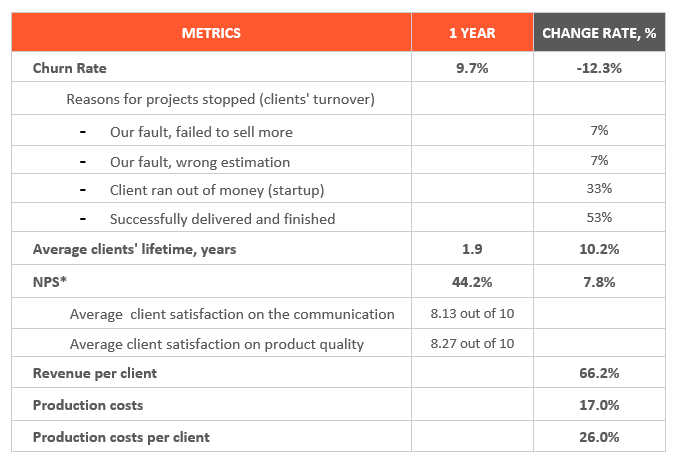
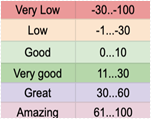 * NPS calculation rules: The clients are labelled
* NPS calculation rules: The clients are labelled
- a Promoter (gave a score of 9 or 10 to their readiness to recommend),
- a Passive (gave a score of 7 or 8), or
- a Detractor (gave a score ranging from 0 to 6).
The score is then calculated by subtracting the percentage of Detractors
from the percentage of Promoters (% of Promoters -% of Detractors= eNPS).
A company’s score can range from -100 to +100.
We reached strong expertise in 10 business domains of our clients:
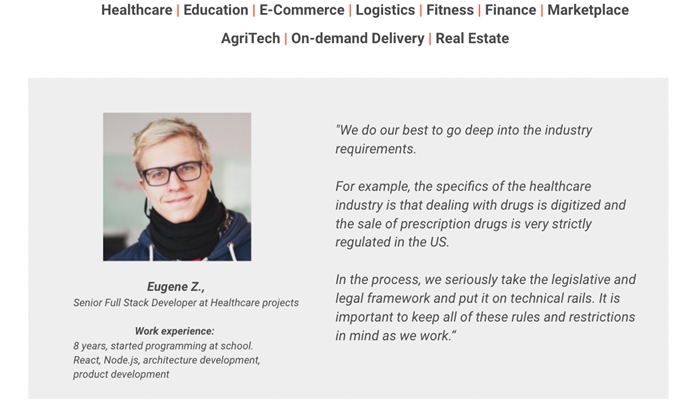
Although we can’t disclose the number of clients for competitive reasons, we can share a significant number of successful cases in targeted business domains and also the referrals of clients on Clutch and on our web-site in the case section (Namecoach, Move, Orsam, Anova, Healthcare project under NDA, etc)
Some examples of our industry solutions and the feedback of clients:
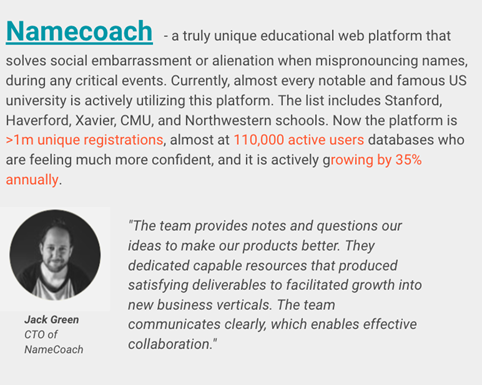
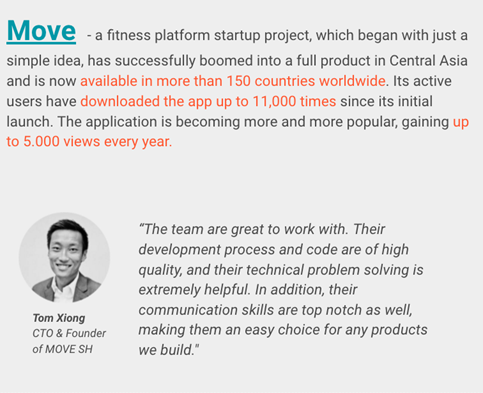
Our people’s health, wellbeing, and happiness resulted in eNPS of 36, which is considered a great result according to the OfficeVibe approach.*
 * eNPS calculation rules: The employees are labelled
* eNPS calculation rules: The employees are labelled
- a Promoter (gave a score of 9 or 10 to their readiness to recommend),
- a Passive (gave a score of 7 or 8), or
- a Detractor (gave a score ranging from 0 to 6).
The score is then calculated by subtracting the percentage of Detractors from the percentage of Promoters (% of Promoters -% of Detractors= eNPS).
A company’s eNPS score can range from -100 to +100.
This is the first time we’ve conducted the survey via OfficeVibe, so we can’t compare the results with the previous period.
At the same time, we have a high level of regrettable turnover of 11% due to our rapid growth and insufficient level of leadership skills among junior-level management. As a result, we have instituted a new training program for key managers.
We’ve done our best to meet all the COVID regulations and have managed to maintain a 3% absence rate (not including vacation), which we consider to be a very good result.

2. Diversity, Equity, Inclusion
We believe that the best way to treat diversity is to pay no attention to it. All people are equal no matter what nationality, ethnicity, gender, age, religion or hair color, etc. It’s expertise and motivation that we seek.
Goals & tactics
Operating in a region with less ethnic diversity than others, we have not had in the past particular goals nor metrics. Now that we are increasing our focus on worldwide recruitment and following the ISO disclosure framework, we are updating our approach to DEI.
We welcome all people with great expertise and motivation. Most of our engineers are historically from the Eastern Europe, but at present we do not have regional or demographic boundaries and 69% of our people work remotely worldwide. The only challenges we have had with international recruitment are related to the difficulties in formalizing working relationships across different countries. Our focus is on countries where we already have people on the ground. Our CHRO is responsible for it.
Metrics and results
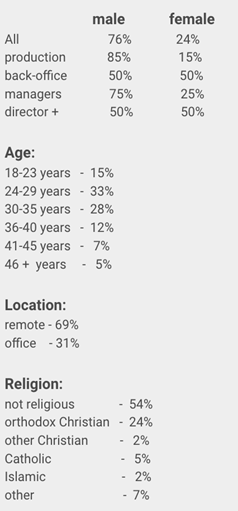 We have equal number of male and female people on the top-management level and in back-office, but most of our engineering is male. We believe our engineering demographics are a reflection of workforce availability, and we are analyzing whether support for training for women engineers is warranted.
We have equal number of male and female people on the top-management level and in back-office, but most of our engineering is male. We believe our engineering demographics are a reflection of workforce availability, and we are analyzing whether support for training for women engineers is warranted.
Most of our people are 24 to 36 years old, but we have no age restrictions, and 12% of people are 40+ years old.
We have a highly diverse audience demographically but do not known the issue related to ethnicity or religion because most work remotely.
The language map can give a clearer understanding of their origin, initial location and diversity.
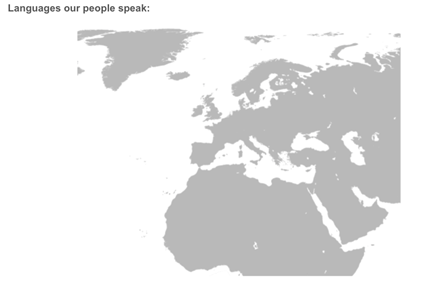
The map shows the locations of our people speaking the following languages: Russian, English, Ukrainian, French, German, Hebrew, Azerbaijani, Belarusian, Italian, Polish, Latvian, Arabian, Tatar.
3. Occupational Health and Safety
People are our key asset and their health and safety directly affect our team climate and performance, thus influencing the happiness of our clients and the success of the company. We are an IT company with 69% of people working remotely, so we’ve never had any cases of occupational illnesses or injuries. Most of our challenges are connected with the pandemic and the remote working reality.
Our CHRO is responsible for Occupational Health and Safety measures and metrics.
Our CHRO is responsible for Occupational Health and Safety measures and metrics.
Goals
● Comply with all the health requirements due to the pandemic situation.
● Maintain our people’s health while working remotely.
Tactics
● Implement all the COVID regulations in all our offices to strictly follow the rules.
● Ensure detailed and regular information of all our people (both in office and remote) about the regulations, safety measures, and the results
● Have a system to be ready to take urgent decisions if needed.
● Implement a set of actions to improve the health of our remote teams.
Metrics and results
We’ve complied with all the health requirements related to the pandemic situation. The entire company followed all the recommendations carefully and tried to reduce all the possible risks. We managed to maintain a 3% absenteeism rate even at the peak of the pandemic, a few people got sick, but none of them had any complications. We are very proud of the result.

We maintained our people’s health while working remotely via remote sport challenges.
Health is unquestionably important. According to the World Health Organization, 27.5% or one in four of the world's population lacks physical activity. It is getting even worse when it comes to working remotely as there is actually no necessity to go out. At the same time the World Health Organization recommends walking at least 10,000 steps a day to maintain basic health.
 It’s a challenge to take care of our team’s health due to the remote location. Medical insurance does not help as it does not support prevention. Gym compensation is nice to have, but it does not really motivate people to go to the gym. We needed some actions to promote regular sport activities.
It’s a challenge to take care of our team’s health due to the remote location. Medical insurance does not help as it does not support prevention. Gym compensation is nice to have, but it does not really motivate people to go to the gym. We needed some actions to promote regular sport activities.
Regular remote sports challenges turned out to be an engaging solution. Every two weeks, we choose one kind of sport (hiking, running, cycling, yoga, morning exercises etc), announce the competition and the goal.
All people willing to participate daily track their progress via a fitness bracelet or via Google Fit, and post their achievements in a sports channel on Slack. At the end of the week, the three most active winners get prizes.
As a result we have 79% of people actively doing sports,
69% participating in the sports challenges and
22% more cheering on the participants
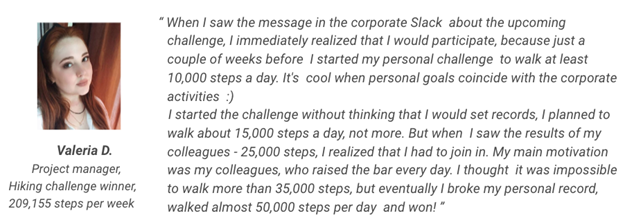
4. Organizational Culture
Goals
People are deeply engaged in the mission to become a long-term business partner for our clients, create awesome SaaS products, and our focus on our clients’ happiness.
We have an employee communications and engagement strategy to consistently promote our organizational values, purpose, and goals through all our engagement and communication tactics so that our employees live our values to achieve high levels of customer and employee satisfaction and willingness to recommend.
Our CHRO is responsible for implementation of organizational culture.
Tactics
● Create a detailed pdf and video presentation in which our CEO talks about our company's story, mission, values, principles and facts (metrics) to measurably show our cultural progress.
● Create a detailed pdf and video presentation in which each of our directors explains to their teams with examples and metrics on how the mission, values, and principles work in their departments.
● Implement an in-depth training program to introduce newcomers to our culture.
● Implement regular meetings to trace the progress and give feedback in terms of strategy and operations, including feedback on culture and engagement:
- Quarterly company meetings with the CEO.
- Every two weeks office meetings with our Heads of Business Units.
- Weekly, monthly, quarterly team (group and department) meetings with the team’s manager
● An every six months recognition plan for specialists, managers and teams tied to goals and values. This is the only change we introduce to our compensation and benefits package, which is already quite sufficient. It includes a competitive base salary, various performance and results bonuses, four-weeks paid vacation, sick pay, employer's pension contribution, medical insurance, maternity and paternity leave, corporate fund of support for employees in a difficult health or family circumstances, up to 100% of any internal training coverage, free English lessons, table tennis and various goodies in our offices. Our compensation and benefits package is highly rated by our people in the OfficeVibe survey.
● Ongoing engagement assessment through OfficeVibe.
Metrics
- % of people deeply engaged in the mission, values and principles.
- Overall employee engagement scores.
- Talent referrals by current employees.
- Employee turnover with the reasons connected to the company’s mission, values, principles, strategy (= lack of motivation and engagement, burnout etc.)
Results
We’ve conducted the survey via OfficeVibe for the first time this year, so have no previous data for comparison.
Our employees’ rate how deeply they are engaged and share the company's mission and values at 9.1 out of 10.
 Our Overall Engagement Score is 7.9, which is considered a very good result according to the OfficeVibe methodology*
Our Overall Engagement Score is 7.9, which is considered a very good result according to the OfficeVibe methodology*
*It is an aggregated rolling 90-day weighted average and it is based on answers members have given on their Surveys, related to its 10 Key Metrics of Engagement.
We are pleased that our people highly value and appreciate the relationship both with peers and with their manager, brand ambassadorship (willingness to refer), personal growth, and alignment. These metrics regularly hit the top five ranking positions.
At the same time, our main areas of improvement are related to recognition, feedback, and overall happiness, with a score less than 8. Thus, a part of our future strategy is to train managers to give sufficient feedback and recognition to their people. We plan to include it in our leadership training and to implement relevant company-wide processes. Also we plan to promote work-life balance and to reduce the level of stress at work to improve overall work-life balance.
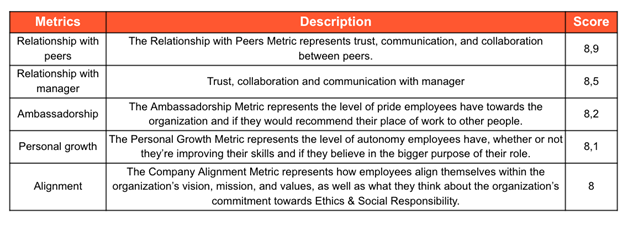
Our eNPS is 36 which is a great result according to the OfficeVibe methodology (already mentioned in the Leadership section).
Better yet, 34% of our people actively use our referral program to recommend their acquaintances to join the company.
5. Productivity
Improving the productivity of our people is one of the key ways to ensure that the company has the necessary talent pool and the required bench strength for the future. Continuous productivity growth combined with high skills and quality is a significant part of our strategy. The details of it are described in the Productivity, Skills, Mobility, Workforce Availability and Bench Strength sections.
Goals
● At least 30% engineering productivity growth annually.
● Maintain the overall company productivity (back-office, commerce etc) at least the level of the previous period.

We also measure the productivity of our engineers at each level (junior, middle, senior) by dividing the revenue made by engineers at that level by the headcount of engineers at that level.
Each manager is responsible for his/her team’s productivity, CHRO is responsible for the productivity of the whole company.
Tactics
We invest a lot of time, effort, and money to train our engineers so that they have higher skills and productivity, and thus regularly move up according to our grade system. Better mobility results in better bench strength, when we recruit juniors, train them, improve their productivity, and thus regularly fill senior engineering positions internally. It also allows us to plan our future talent pool and to ensure that we have no problems with our future workforce availability. We’ve followed this strategy since 2015, when we first launched our internal Academy for professional development.
Metrics and Results
78% оf our engineers improved their productivity and their grade.


We reached the goal of at least 30% productivity growth of engineers annually and maintained the productivity of the rest at the level of the previous period.

6. Skills and Capabilities
Improving productivity of our people is one of the key ways to ensure that the company has the necessary talent pool and the required bench strength for the future.
Continuous productivity growth combined with high skills and quality is a significant part of our strategy. The details of it are described in the Productivity, Skills, Mobility, Workforce Availability and Bench Strength sections.
Goals
To accomplish the planned trainees, specialists, and leadership training programs to reach the productivity, mobility, and bench strength goals (see corresponding sections.)
Head of Engineering is responsible for the training and development in engineering, he also manages a team of career managers who conduct the development of engineers. CHRO is responsible for the training and development of the whole company.
Tactics - Students' and Trainee Development
Tactics - Students' and Trainee Development
Technologies are changing rapidly. There is no good traditional university education for programming. Most engineers start coding at school and learn almost everything themselves. We do our best to teach prospective ones the basics of programming from scratch and then give the successful candidates a job and provide ongoing training
Internal Academy. We run quarterly courses on Ruby/Ruby on Rails, React.js, iOS, Android, Quality Assurance and Product Management. Trainees have an apprenticeship contract and are paid a monthly scholarship.
We do not have restrictions on gender, age or previous experience. We believe it’s never too late to start programming. Often mature age goes together with organisation, responsibility and high motivation. We have a solid number of successful trainees of 40-plus years or older.
Working practice and lectures at the local university. Our key managers, including CEO and Head of Engineering regularly teach at the local universities. We train 2nd-4th year students to give them the basics of Computer Science and Software Engineering at the university so that by the time they graduate they already have good knowledge and can easily join our Academy.
Metrics and Results - Students and Trainee Development
Our internal Academy was launched in 2015.We have four training courses and up to 100 trainees per year with a 38% conversion rate (successfully accomplished).
We conduct permanent working practice and lectures at the university since 2016, In 2020-2021, we had 194 students. Some of them will join our Academy as they graduate.

Tactics - Internal Specialists Training and Development
● Transparent grades and T&D system. We have a system of grades (junior-middle-senior levels) with transparent and objectively measurable promotion criteria. This includes hard and soft skills, practical results and performance KPIs, and also the feedback from the team and manager. The review is taken regularly twice a year. As a result, each person gets substantial feedback and a detailed individual development plan.
● Career management system. Each of our engineers has an individual career manager from the very first day in the company. Career managers are senior or lead engineers responsible for mentoring their junior colleagues according to their development plan. It’s an official responsibility with allocated working hours and pay additional to their regular engineering work. It is considered an honorable contribution to the company and is a part of a leadership career path.
● External training at the company's expense. Each person can choose to attend any external training, webinar, conference etc. relevant to his/her professional skills and the company will pay up to 100% for it. We believe it’s important that our people expand their horizons through any external sources they are comfortable with.
Metrics and Results - Internal Specialists Training and Development
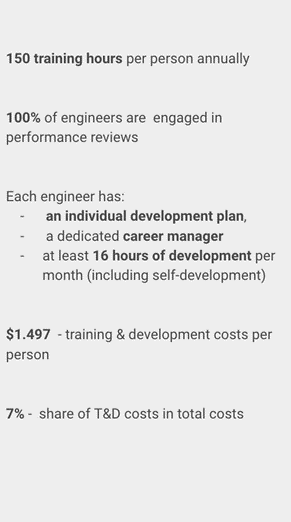
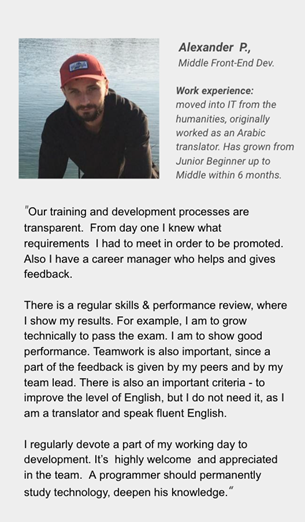
Tactics - Leadership Training and Development
This year we’ve launched an in-depth internal leadership program. The key goal is to start a regular training program which will take part every two quarters and will ensure that all our current leaders have high people-manager skills and that we systematically train our future leaders to maintain our bench strength.
The training takes two quarters and includes theoretical basics on psychology and people-management along with substantial hands-on practice with subordinate teams.
Within the program, each manager has a number of goals both on their team results (KPIs) and on people development (at least two subordinates with different soft or hard skills development areas). It can be about helping a newcomer to succeed during the probationary period and a top-performer overcome a conflict with the team.
The success of the leadership program and the decision on the managers’ perspectives is evaluated upon the achievement of these goals.
Metrics and Results - Leadership Training and Development
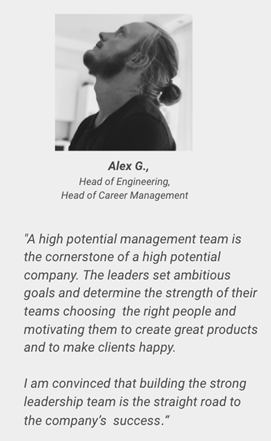 The training was conducted for 35% of our managers and took 900+ hours plus multiple hands-on practice with subordinate teams as an everyday routine over a six- month period.
The training was conducted for 35% of our managers and took 900+ hours plus multiple hands-on practice with subordinate teams as an everyday routine over a six- month period.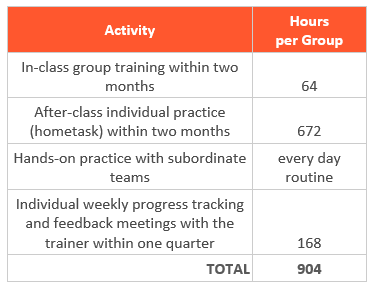
The managers are still in the process of their hands-on Leadership training program, and the results will be evaluated in the beginning of 2022.
7. Recruitment
Goals
Maintain at least 50% annual headcount growth to support our business strategy.
Our CHRO is responsible for recruitment.
Tactics
● We hire remotely worldwide and welcome all nationalities. Most of our engineers are originally from the Eastern Europe, but at present we do not have regional or demographic restrictions and 69% of our people work remotely worldwide.
● Our recruitment is mostly focused on senior + people, as we acquire juniors via our Academy and Universities and develop them up to middle-level developers.
● Our talent acquisition is performed by an internal talent acquisition team of five recruiters and a team lead (based on average headcount). To enhance recruitment effectiveness, we expand the recruitment team up to ten people, allocate a head of recruitment and refine our talent acquisition processes through automation.
● To enhance recruitment effectiveness, we refine our processes so that our adaptation is performed by the persons’ manager with significant involvement of his/her mentor (Career Manager) and HR. On the first day of work, the manager explains to the newcomer the criteria for passing the probationary period. The criteria are objective and measurable, usually including the soft and hard skills, the performance results (KPIs) and the feedback of the manager and peers.

Metrics and Results
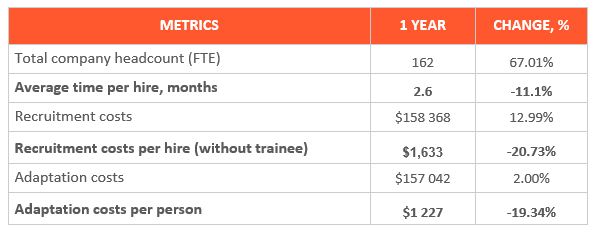
We’ve managed to reach the headcount growth goal and to cut the recruitment and adaptation costs per person by 20% and by 19% correspondingly, which is a good result.
8. Employee Bench Strength, Mobility and Turnover
Goals
● Maintain at least 70% annual mobility (moving up according to the grades) in engineering and thus fill at least 50% of middle+ engineering positions internally.
● Implement the system of leadership training to ensure the future leadership mobility and bench strength.
● Implement a system to effectively work with turnover in the future taking into the consideration the rapid company growth and the remote teams
Head of Engineering and his career managers are responsible for the turnover in engineering. Each manager is responsible for the turnover of his/her subordinates.
CHRO is responsible for the company's turnover reduction strategy.
CHRO is responsible for the company's turnover reduction strategy.
Tactics
● Accomplish the planned trainee, specialists and leadership trainings to reach the skills & productivity and thus the mobility and the bench strength goals.
● Implement the system of metrics to analyse turnover in terms of function, level, location etc to have sufficient data to make decisions.
● Implement the in-depth exit interview both with the leaving person and with his manager to analyse the reasons of turnover.
Metrics and Results - Mobility and Turnover

We’ve managed to maintain a 78% engineering mobility. Although we also dealt with a 12% regrettable turnover, we managed to fill 52% of middle + positions internally through our junior and middle people development.
Due to the rapid growth of our company, we are also in great need of prominent leaders. We managed to fill 50% of leadership positions internally. This past year, for the first time, we’ve hired four senior managers from the outside to meet our demands.

The total company’s mobility resulted in 70% with 11% of regrettable turnover.
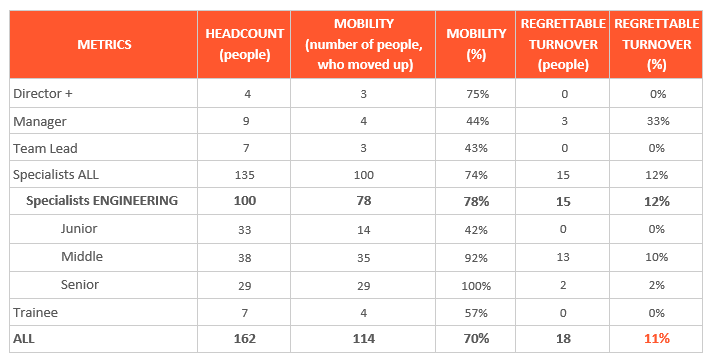
Action Plan
The turnover rate is a matter of concern and requires special attention at all times and especially in the period of rapid company growth and remote working. We plan to implement the following actions in 2022:
● Devote a great part of the leadership course to train managers to recruit, to adapt, to motivate etc. their teams working remotely.
● Introduce the turnover of the subordinate team to the manager’s KPIs and the overall turnover to the company’s strategy.
● Give regular feedback on turnover dynamics at company meetings with CEO/ Department Heads and individual feedback at one-to-one meetings with managers.
9. Customer Engagement
Our clients are the cornerstone of our company’s mission and all our strategy is focused on their success and happiness. Most of the strategy has already been described in detail in the Leadership section. Here we give more information about our clients location, industry, type of business etc.
Goals
● Focus on partnership, client’s engagement and happiness to increase our value as a partner at the business level, at the management level, and at the level of the entire team. So that our people think in terms of the client’s needs, focus on long-term relationships and become an ideological part of the client's team.
● Focus on strong expertise in the business domains of our clients to provide the best industry-focused solutions. This also includes significant people training to acquire the top level of skills and to ensure that each project is quickly stuffed with the best and highly productive people.
It’s our culture and each person in the company is responsible for it. Each function has corresponding KPIs, which reflect how well the division complies with the company's mission, values, and principles. Our CEO and CHRO are responsible for the goals on the level of the whole company.
Tactics
● Implement a client-oriented culture, so that our people think in terms of the client’s needs, focus on long-term relationships, and on becoming an integral part of the client's team (for detailed tactics see the Organisational Culture section.)
● Develop and introduce to the market the top industry-focused solutions (the responsibility of our Production and Marketing managers.)
● Significant industry-focused people training to acquire the top level of skills (see the Skills section for detailed tactics).
● Ensure that each project is quickly staffed with the best and highly productive people (see the Mobility and Bench Strength sections for detailed tactics)
Metrics and Results
We work both with startups and with enterprises that have a need to develop a tech solution for themselves or for the market. We welcome diversity and partner with all the clients without limitations in terms of geography, size, or industry.
At present we work with clients from the following countries: Bahrain, Canada, China, Finland, France, Germany, Latvia, Portugal, Russia, UK, USA, Sweden, Mexico, Kuwait, UAE). In the US, we have clients in: Austin (TX), Minnesota, Boise (ID), New York, Chicago, Palo Alto (CA), Redwood City (CA), Renton (WA), Miami, Saratoga (CA), Florida, Denver, Napa (California), San Francisco (California).

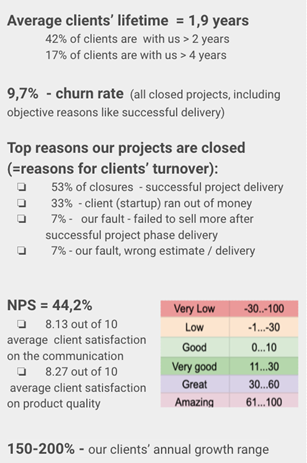 Because we focus on helping clients create new applications that they can maintain themselves, having high levels of engagement creates more business by having clients come back for us to help them enhance or create new applications.
Because we focus on helping clients create new applications that they can maintain themselves, having high levels of engagement creates more business by having clients come back for us to help them enhance or create new applications.
Within the year, our client’s engagement and happiness resulted in 44.2% NPS
which is 7.8% growth in comparison to the previous period.
Most of our clients are our long-term partners. Our clients’ churn rate is 9.7% and average clients’ lifetime is 1,9 years, which is a slightly better result than in the previous year.
We are especially proud that our clients’ annual growth range is 150-200% which shows that the products we deliver are highly welcomed and enjoyed by our clients’ customers.
We highly appreciate the significant number of positive referrals of our clients which allows us to permanently acquire TOP ratings:
● TOP ratings by Clutch during five years (2017-2021)
● Top Mobile App Development Companies for Startups during two years (2020-2022)
Also according to our OfficeVibe survey, our people rate 9.1 out of 10 how deeply they are engaged and share the company's mission and values focused on our clients’ happiness.
10. Supply Chain and Channel Partners
This section is not applicable as we do not have any significant Supply Chain and Channel Partners
11. Community Engagement
The engineering community is always friendly, open, and has historically encouraged free contribution and collaborative development. True engineers are natural to share and we are not an exception.
Goals and Tactics
Our goals are to develop a pool of talent from which we can recruit employees.
● Contributing to the engineering community. We have been an active member of RubyGems and GitHub since 2017. Our people regularly contribute useful code pieces in Ruby, Java, JavaScript, Kotlin, Python for free. Judging upon the number of downloads, our contributions are highly appreciated by the community.
● Contributing to candidates with low hard skills. We have a Coding Challenge for all junior positions and a Skills Matrix interview for all the rest in engineering. All the candidates who fail due to low hard skills get detailed and substantial feedback from our tech interviewers with the possibility of further refinement and repeated feedback. We also give a good list of recommendations, what to read/watch to learn the topic. With our contributions, these candidates can improve their skills and become better professionals in the future.
Our Head of Engineering and Career Management is responsible for it.
Metrics and Results
Fostering engineering community worldwide since 2017, we’ve reached more than 8,9 million downloads of our code pieces by now
1400+ candidates with low hard skills annually go through our coding tests and receive detailed feedback for future development.
Addendum
1. Costs
Goals
We manage people costs as a % of revenues and against customer engagement scores to ensure that we are achieving a ROI from our people while focusing on our clients’ success and happiness.
Top managers are responsible for their teams’ costs. All people costs are the KPIs of our HR strategy and are the responsibility of our Chief HR Officer.
Tactics
● Our annual human capital management plan includes clear cost metrics for each function related to people management.
● We track the revenue to headcount metrics at engineering levels (grades) to ensure that our investment results in skills, quality and productivity.
Metrics and Results
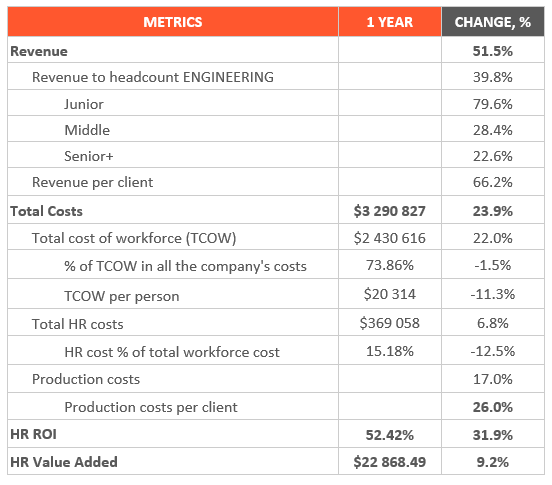
We’ve reached HR ROI of 52.42% and improved our revenue to headcount metrics by 39.8%, which is a significant result.
Although the absolute total cost of all the HR functions increased alongside with the total company’s costs, we managed to improve the level of HRr costs per person which indicates the increase of HR effectiveness.
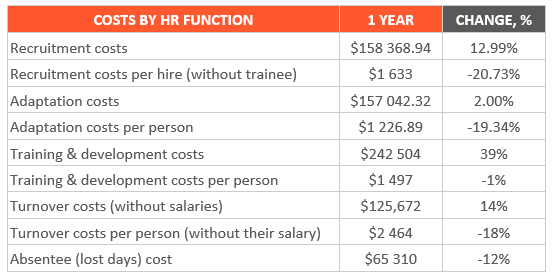
2. Compliance
Goals
● Comply with tax and employee regulations in three countries where we have offices and employees.
● Comply with the regulations applicable to our contractors.
● Comply with the COVID regulations including the remote teams.
● All our people comply with our Code of Conduct and Ethics.
Law and finance (tax, etc.) compliance is the responsibility of our Head of Legal and CFO. The rest is the responsibility of CHRO.
Tactics
● Ensure knowledge on the regulatory context at all times, including the communication of the information to the people involved.
● Partner with the regulatory context experts (finance, tax, law) to avoid risks.
● Implement regular training on our Code of Conduct & Ethics obligatory for all our people.
● Ensure all the people follow all the COVID recommendations carefully.
● Implement a system of easy and friendly communication on the internal policies and regulations (User Friendly Support, FAQs, regular feedback and communication with managers)
Metrics and Results
We are an IT company with mostly remote people, so we’ve never had any cases of occupational illnesses or injuries, grievance for any reason (harassment, discrimination etc), disciplinary actions, disputes referred to external parties, etc.
We comply with all the requirements in the countries where our offices are located (the USA, the Ukraine, Russia). 100% of our people including remote teams go through the training according to our Code of Conduct & Ethics.
We also comply with all the health requirements due to the pandemic situation as it is really important even if most of the teams are working remotely. Covid made us quickly regroup and focus on what was most important. We focused on the health and well-being of our people. We managed to maintain a 3% absenteeism rate even at the peak of the pandemic, a few people got sick, but none of them had any complications. The pandemic taught how to be careful about our own health and the health of the people near us.
3. Workforce Availability
To satisfy our clients it’s important to dedicate capable resources and to staff the project teams in time. Engineering workforce availability is currently a crucial matter for any tech company. To predict the possible workforce shortage and to ensure that the necessary talent pool is available at all times, we focus on the following goals.
Goals
● Talent acquisition: we hire remotely worldwide and welcome all nationalities. Most of our engineers are originally from the Eastern Europe, but at present we do not have regional or demographic restrictions. and 69% of our people work remotely worldwide.
● External training and development for students and beginners.This includes our Academies and regular lectures for local university students in the regions where we have offices.
● Internal training and development: permanent development of our people. This includes both specialist and leadership training and allows to create sufficient bench strength.
Head of Engineering and his career managers are responsible for the workforce availability in engineering. CHRO is responsible for the whole company’s workforce availability,
Tactics
Talent acquisition, training and development actions were described in the relevant sections above.
Metrics and Results
Talent Acquisition. The number of relevant potential workforce in the Eastern Europe is increasing, thus we are not supposed to experience hiring problems so far as we hire remotely.
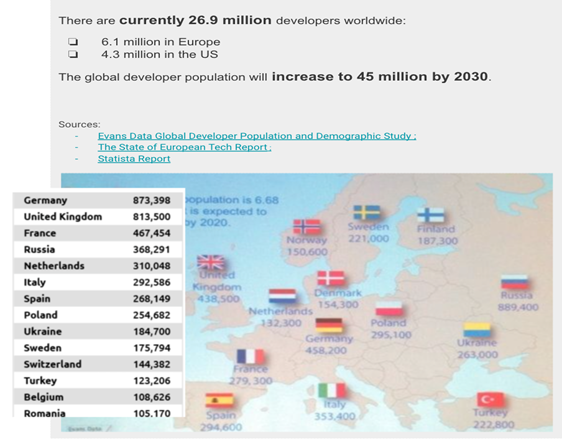
External training and development: students and beginners. The number of IT graduates in the regions where we have offices is about 20, 000 per year.That's a huge number of potential employees in the future.
Internal training and development: permanent development of our people. We maintain high mobility in engineering and at present fill 52% of middle and higher positions internally through our junior and middle people development. This strategy allows us to ensure a sufficient future workforce availability.
Master the “S” of Environmental, Social, Governance (ESG), A.k.a. Stakeholder Capitalism
The Enterprise Engagement Alliance at TheEEA.org is the world’s first and only organization that focuses on outreach, certification and training, and advisory services to help organizations achieve their goals by fostering the proactive involvement of all stakeholders. This includes customers, employees, distribution and supply chain partners, and communities, or anyone connected to an organization’s success.
Training and Thought Leadership
- Founded in 2008, the Enterprise Engagement Alliance provides outreach, learning and certification in Enterprise Engagement, an implementation process for the “S” or Social of Stakeholder Capitalism and Human Capital Management and measurement of engagement across the organization.
- The Enterprise Engagement Alliance provides a training and certification program for business leaders, practitioners, and solution providers, as well as executive briefings and human capital gap analyses for senior leaders.
- The EEA produces an education program for CFOs for the CFO.University training program on Human Capital Management.
- Join the EEA to become a leader in the implementation of the “S” of ESG and Stakeholder Capitalism.
- The ESM information portal and The Enterprise Engagement Advisors Network solution provider marketplace cover all aspects of stakeholder engagement, and the EEA information library lists dozens of resources.
- The RRN information portal and Brand Media Coalition marketplace address the use of brands for gifting, incentives, recognition, and promotions. The BMC information library provides information and research resources.
Video Learning
The EEA Human Capital Management and ROI of Engagement YouTube channel features a growing library of 30- to 60-minute panel discussions with leading experts in all areas of engagement and total rewards.
- Enterprise Engagement for CEOs: The Little Blue Book for People-Centric Capitalists. A quick guide for CEOs.
- Enterprise Engagement: The Roadmap 5th Edition implementation guide. A comprehensive textbook for practitioners, academics, and students.
Enterprise Engagement Advisory Services
The Engagement Agency helps:
- Organizations of all types develop strategic Stakeholder Capitalism and Enterprise Engagement processes and human capital management and reporting strategies; conduct human capital gap analyses; design and implement strategic human capital management and reporting plans that address DEI (Diversity, Equity, and Inclusion), and assist with managed outsourcing of engagement products and services.
- Human resources, sales and marketing solution providers profit from the emerging discipline of human capital management and ROI of engagement through training and marketing services.
- Investors make sense of human capital reporting by public companies.
- Buyers and sellers of companies in the engagement space or business owners or buyers who seek to account for human capital in their mergers and acquistions.
For more information: Contact Bruce Bolger at Bolger@TheICEE.org or call 914-591-7600, ext. 230.


